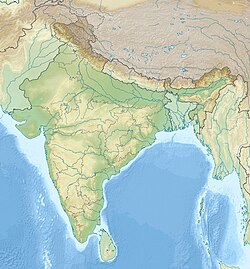
Back كهوف باغ ARZ Grottes de Bagh French બાઘ ગુફાઓ Gujarati מערות באג HE बाघ की गुफाएँ Hindi ဘဂ်ဂူများ Burmese बागगुहाः Sanskrit බාඝ් ලෙන් Singhalese பாக் குகைகள் Tamil బాగ్ గుహలు Tegulu
Bagh Caves | |
 The Bagh caves | |
| Coordinates | 22°19′21.63″N 74°48′22.36″E / 22.3226750°N 74.8062111°E |
|---|---|
| Type | Buddhist caves |
The Bagh Caves are a group of nine rock-cut monuments, situated among the southern slopes of the Vindhya Range in Bagh town of Dhar district in Madhya Pradesh in central India.[1] These monuments are located at a distance of 97 km from Dhar town. These are renowned for mural paintings by master painters of ancient India. The caves are examples of Indian rock-cut architecture, rather than naturally formed.[citation needed]
The Bagh caves, like those at Ajanta, were excavated by master craftsmen on perpendicular sandstone rock face of a hill on the far bank of a seasonal stream, the Baghani. Buddhist in inspiration, of the nine caves, only five have survived. All of them are 'viharas' or resting places of monks monasteries having quadrangular plan. A small chamber, usually at the back, forms the 'chaitya', the prayer hall. Most significant of these five extant caves is the Cave 4, commonly known as the Rang Mahal (Palace of Colors).
The Bagh Caves were quarried in the 5th-6th century AD, in the very late stages of Buddhism in India, and long after most of the Indian Buddhist caves had been built, many of them since the 2nd or 1st centuries BCE.[2]
They are believed to have been built during the 5th-7th century. The Archaeological Survey of India has restored the caves over 17 years.[3]
- ^ "Places to Visit: Official Website of District Administration Dhar". dhar.nic.in. Archived from the original on 18 December 2010.
- ^ Dutt, Sukumar (1988). Buddhist Monks and Monasteries of India: Their History and Their Contribution to Indian Culture. Motilal Banarsidass. p. 162. ISBN 9788120804982.
- ^ "Bagh Caves: Palace of Colours".

